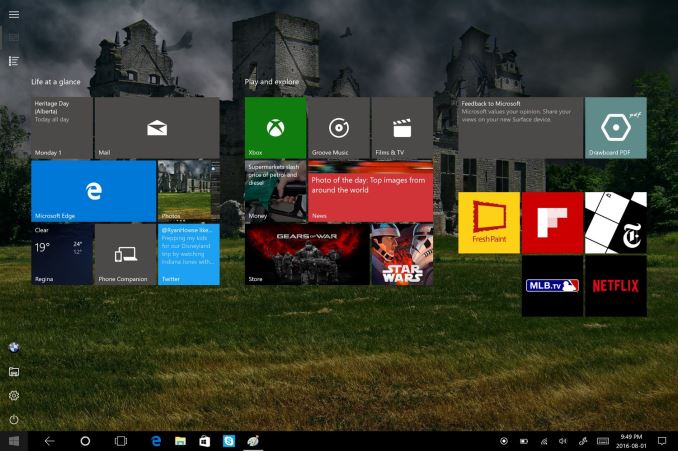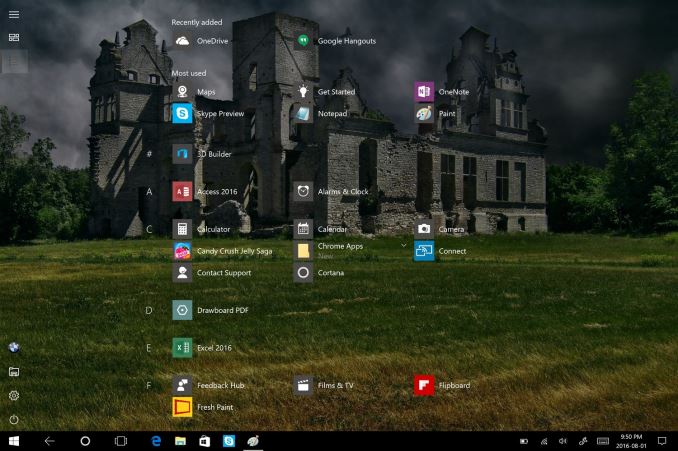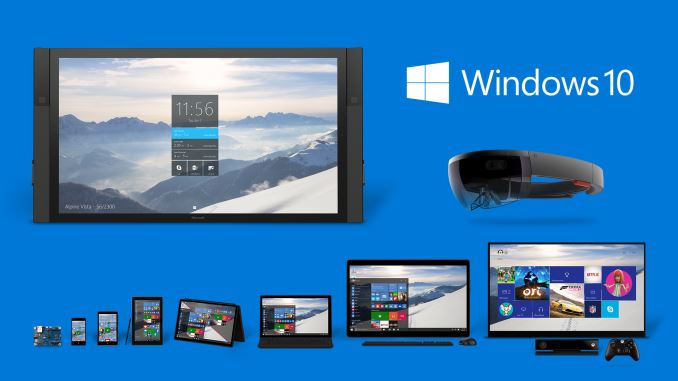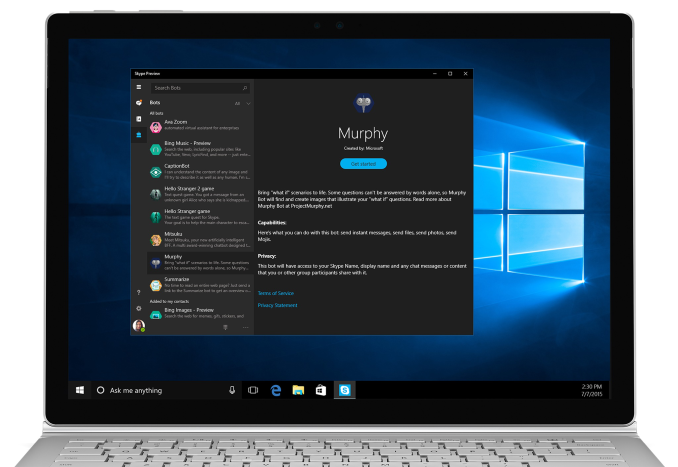Windows 10 Anniversary Update: The Road To Redstone
by Brett Howse on August 2, 2016 8:00 AM EST- Posted in
- Operating Systems
- Microsoft
- Windows 10
Tablet Mode changes, Windows Everywhere, and Skype
Tablet Mode
When Windows 10 launched, Tablet Mode, aka Continuum, was the new solution to offer Windows 10 across both traditional desktop computers, as well as touch first, or touch only devices like tablets. Overall, the interface worked well enough, but it was a step back from the usability of Windows 8.1 as a tablet interface. Still, the balance of desktop versus tablet was improved greatly with Windows 10, so it was a net win. With the Anniversary Update, Microsoft is bringing some of the Windows 8.1 features back to improve Tablet Mode.
The first change is the Start Screen layout. It’s still the same basic design, but the left hand side has been adjusted to make it more usable. The hamburger menu stays at the top, but directly under it is now the All Apps button. Toggling this switches from the Start Screen to All Apps much more akin to how it was in Windows 8.1, with a full screen scrollable list, rather than just a list on the left side. It makes it a lot easier to scroll more apps quicker, and see everything you have installed. Also, the left side contains icons for File Explorer, Settings, Power, and logout. It’s a subtle change, but it really is a lot more usable now.
Another thing that was missing was the full-screen tablet experience: in Windows 8.1, full-screen apps would lose the taskbar at the bottom. When Windows 10 shipped, the taskbar would stay planted at the bottom. There’s now an option to auto-hide the taskbar to make it a more immersive feel. I personally really liked the taskbar, since it makes it much easier to switch apps, but it’s nice to have the option back for those that prefer it.
The browser is a big part of tablets, and this has already been mentioned, but the addition of swipe navigation in Edge helps a lot as well.
Tablet Mode has improved a lot since the initial release, and these changes, added to previous changes such as the ability to toggle on “more tiles” makes the latest update much better to use. It’s likely still not quite as good as Windows 8.1 was, but the net gain with the much better desktop is still a better overall solution.
Windows Everywhere
It’s been Microsoft’s goal for a long time to bring Windows 10 to all devices, and that was a tall hill to climb. But, it has happened, and users of Windows can now experience the benefits of the work to get here. Windows 10 Mobile is not a different operating system, but the same Windows 10 base with a different UI to make it work better on the small touch screen. With Microsoft’s failure to establish a foothold in the mobile market, it’s almost too little, too late, but regardless, fixes and changes they make to Windows 10 also find their way to the phone. This is as simple as the new mail app, updated to support multiple sending accounts, instantly worked on the phone too since it’s a Universal Windows App. What’s more, Windows has been expanded to work on devices as small as IoT, to Hololens, to the ultra-large screen of the Surface Hub.
This work has also expanded to the Xbox One, and with the Summer Update for Xbox rolling out on July 29th, the fruits of this labor has already been seen. The latest Xbox update offers much of the same interfaces as Windows 10, including slide-out menus with a hamburger button, as well as the ability to (finally) run Universal Windows Apps. The Movies and TV app on the Xbox is the exact same one as on the PC, which is the exact same one as on the phone. Updates to the UWP will fix issues on all three.
It’s been a long road, and the casualty of the march to where Microsoft made it is the loss of the mobile market. They’ve transitioned there to providing apps and services, but Windows 10 Mobile is now pretty good at a time where it’s unlikely most people will ever use it.
Skype
And how can we forget Skype? Skype’s had a long and arduous road to where it is now, but it seems like it’s finally become a focus of the company. With the Anniversary Update, we see our first look at the new UWP version of Skype, replacing the old WinRT version, and likely eventually the Win32 version as well. It’s been out in preview for a while, and overall it’s been pretty solid.
It offers a dark mode, much like many of the Microsoft UWP apps, and the same UWP exists on Windows 10 Mobile as well. Likely the biggest feature is one that hasn’t made it to Skype yet. Microsoft has promised to add SMS support within Skype, so you can use Skype as a portal for both Skype messages and SMS. It’s something that they already had in Windows 10 Mobile when it first shipped, but it was later removed, and then a new Messaging app was tested, which was also killed off. The final solution is to use the Skype UWP to allow you to send SMS messages from your PC, and assuming it’s not too far out, that’s a decent solution considering how much better the Skype UWP has been.














194 Comments
View All Comments
jlabelle2 - Tuesday, August 16, 2016 - link
- how many of us want a private, customizable (think no Cortana / Store / forced updates / automatic removal of programs) OS?It is not because they are idiot people out there that Microsoft should cater their OS for those.
Cortana is nothing more than a search if you disable all the tailor made options.
Removing Windows Store is like asking that OS would run without softwares and cars without wheels. Store apps have inherent advantages compared to Win32 programs (more secured, uninstall without leftovers, free up memory automatically, scale perfectly, support all input types, integrate with notification center / share API / Cortana, roam the settings accrias devices...) that make them (when they do what you want) factually better that Win32 programs. Nobody is forcing anyone to install them but removing the Store is just an utterly silly request.
And at last, regarding automatic updates, we all know, reading those forums what is the perception of average Joe toward Windows PCs being prone to viruses / malwares / slow down compared to tablets like iPad and this is the smartest decision from Microsoft to force update and back in Windows Defender plus Store apps to give people the same advantages as iPad in term of simplicity / security / continuity of performance while still allowing users to use the millions of legacy Win32 programs if necessary.
jlabelle2 - Tuesday, August 16, 2016 - link
What is Cortana if you removed all points of interest except a glorified search? Why people are asking the possibility to disable Cortana? This is beyond me especially people that do think they understand computer better that my mom. Do not want to use search, do not. Simply as that.looncraz - Tuesday, August 2, 2016 - link
This is basically an article highlighting all of the things I remove from Windows 10 to make it a palatable platform. Except Bash.Dark mode also works in the original Windows 10, you just have to manually set a registry key.
baka_toroi - Tuesday, August 2, 2016 - link
Call me paranoid, but I see the combination of project Centennial and the impossibility of rejecting Windows updates as a surefire way to block Win32 apps in the distant future. "We know better than you, boy. Don't try to do as you wish to do with your own computer." In other words, an Apple world.Sure, there will be jailbreaks and stuff but we all know it's not the same as having legitimate access to your whole system.
Michael Bay - Tuesday, August 2, 2016 - link
That day sure is coming, but not any time soon. Way too much legacy sw still in active circulation.prophet001 - Tuesday, August 2, 2016 - link
Why do people just swallow this hook line and sinker?I know why: Ignorance.
Michael Bay - Tuesday, August 2, 2016 - link
If you`re not using some banking client from 80s, there is little use in holding on tightly to win32. It`s not like they are restricting your ability to develop under winrt and will likely start some kind of transition program for developers like Apple did.Ascaris - Wednesday, August 3, 2016 - link
Win32 programs are for regular desktop or laptop PCs. UWP is for tablets and phones. There's already too much of the horrendous UWP "design language" in desktop Windows 10-- I'm certainly never going to add to it with anything "app." When I had a Windows 10 installation on my test PC, I uprooted Windows Store, Cortana, Edge, and all of that kind of stuff... most satisfying thing I ever did with 10, other than wiping the drive when I finally gave up on 10 ever becoming a usable OS.All the stuff about "it uninstalls cleanly" that we hear about UWP is certainly a good thing, but there's nothing inherent about Win32 that makes this inevitable (other than the existence of the registry in general). In the Win 95 days and prior, Windows pretty much allowed any installer to make any change it wanted. It was common for installers to sprinkle DLLs into the Windows directory, sometimes overwriting system files. They were allowed to do most anything with the registry. There was no enforced or even theoretical schema to any of it... it was just "do whatever you want."
A big part of Windows 95's crashiness can probably be directly attributed to this.
Later versions tightened it up some, but installers still have considerable authority to make changes that are not adequately tracked by the system. That doesn't have to be.
If the changes with UWP were mainly about fixing this, that would be one thing, but that's not the main reason for it. It's so "apps" can run on multiple platforms. Maybe some people will be happy running phone apps on their PCs, but I won't. Too many compromises have to be made to make it sorta-work on devices as dissimilar as a touch-screen 5 inch phone (that is usually held in portrait) and a PC with three times the CPU and GPU power and nearly unlimited local storage with a 24" screen that is always in landscape, with input via an actual keyboard and a mouse.
Of course, I know that the idea is that some "apps" will be strictly PC, but those are not the point of UWP. The point is trying to unify dissimilar and ergonomically incompatible computing platforms, even though there are good reasons why PC and mobile UI design parameters are different and distinct.
jlabelle2 - Tuesday, August 16, 2016 - link
- Win32 programs are for regular desktop or laptop PCs. UWP is for tablets and phonesThis cannot be further of the truth. This is an arbitrary split that you are spreading as if everything should be split like Apple decided (even if they are themselves coming back from those toaster/fridge complain as the iPad Pro is proving).
The one advantage you claim from UWP is real. And many others are. It seems that you would have liked Microsoft to evolve Win32 to integrate all the UWP advantages than starting from scratch. Whatever was the best way to proceed, UWP offers clear and undeniable advantages, even purely on desktop compared to Win32 apps (see some that I mentioned above).
- It's so "apps" can run on multiple platforms
Exactly. And as such, that is already a very important advantage that Win32 does not share. And honestly, mobile being so important these days, it is clear that it is much more clever from Microsoft to push applications that could run as well on laptop, tablet or even mobile phone than legacy Win32 softwares.
- Maybe some people will be happy running phone apps on their PCs, but I won't
I am. Because there are nothing specifically phone related. For instance, Drawboard PDF has simply no Win32 equivalent. And there are plenty examples of those.
And there is no reason why phone apps advantages would not be valid when used on a tablet or desktop or laptop.
- Too many compromises have to be made to make it sorta-work on devices as dissimilar as a touch-screen 5 inch phone
Not really as the interface can morph and adapt to the screen size so indeed, UWP are quite flexible on tis regard. You are trying to create a dichotomy that simply does not exist anymore.
Many people are using tablet or laptop with touchscreen. Keyboard is natural input method, even on phones (be it on-screen keyboard). Pen can act virtually like a pointing device making applications benefiting from a mouse very much as usable with a pen on a tablet.
Also, even if laptop or desktop have bigger screen, they are also used from further away.
You are mentioning the aspect ratio but this is something UWP manage very well. A good example is for instance Outlook which is using 3 different vertical panes on phones (account and forlder list,mail list, mail content pane) that can be all displayed at once on a desktop / laptop landscape screen.
Indeed, UWP is an evidence that there is so much overlap that the distinction that Apple is still trying to promote (even if contradicting themselves with the iPad Pro) is not making sense anymore. Google has realize that as well with Android apps running on Chromebook.
- here are good reasons why PC and mobile UI design parameters are different and distinct.
If there were "PC" on one side and "mobile" on an another, where does tablets and laptop fits ?
Daniel Egger - Tuesday, August 2, 2016 - link
lol, Microsoft passed Apple a *long* time ago when it comes to restrictiveness and lack of privacy. Actually it was right at the time when they introduced "Genuine Advantage"...